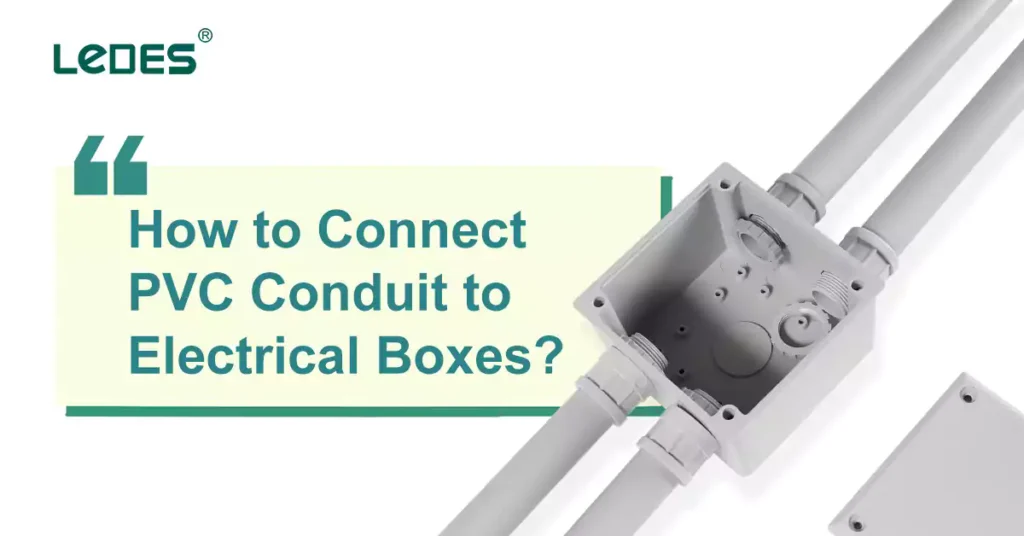
目录
电气安装需要一丝不苟的方法来确保正确接线和安全。这些安装的一个关键方面是如何将 PVC 导管连接到电气箱。PVC 导管用作电线的保护外壳,保护电线免受损坏并提供整洁有序的外观。在本指南中,我们将探讨将 PVC 导管连接到电气箱的重要性,并为您提供有效完成此任务的分步过程。
PVC导管与电气箱连接的重要性
将 PVC 导管连接至 电气箱 由于多种原因,这是电气安装中的关键步骤。 首先, 它为电线提供安全封闭的通道,保护电线免受物理损坏、潮湿和其他环境因素的影响。导管充当屏障,保护电线免受潜在危险,并降低触电或短路的风险。
第二, 将 PVC 导管连接到电气箱可确保正确组织和管理电线。它允许采用结构化和系统化的方法,使将来的故障排除、维修和升级更加容易。通过整齐地将电线布置在导管内并将其连接到适当的电气箱,您可以创建一个整洁且易于访问的电气系统。
最后, 将 PVC 导管连接到电气箱符合电气规范和规定。这些规范旨在促进安全标准并确保电气安装以合规方式进行。将导管正确连接到电气箱是满足这些要求和维护安全电气环境的重要组成部分。
在本指南中,我们将深入研究将 PVC 导管连接到电气箱的过程。我们将探讨安装中常用的各种类型的电气箱,包括接线盒、开关盒和插座盒。此外,我们将考虑诸如导管类型(刚性或柔性)和制造电气箱所用材料(金属或非金属)等因素。
通过遵循提供的分步说明,您将获得必要的知识和技能,自信地将 PVC 导管连接到电气箱。无论您是 DIY 爱好者还是专业电工,了解此过程对于确保安全可靠的电气系统都至关重要。
6 种电气箱类型
配电箱的类型很多,连接 PVC 导管的方法也各有不同。以下是一些常用的配电箱类型。
接线盒(定义和用途)
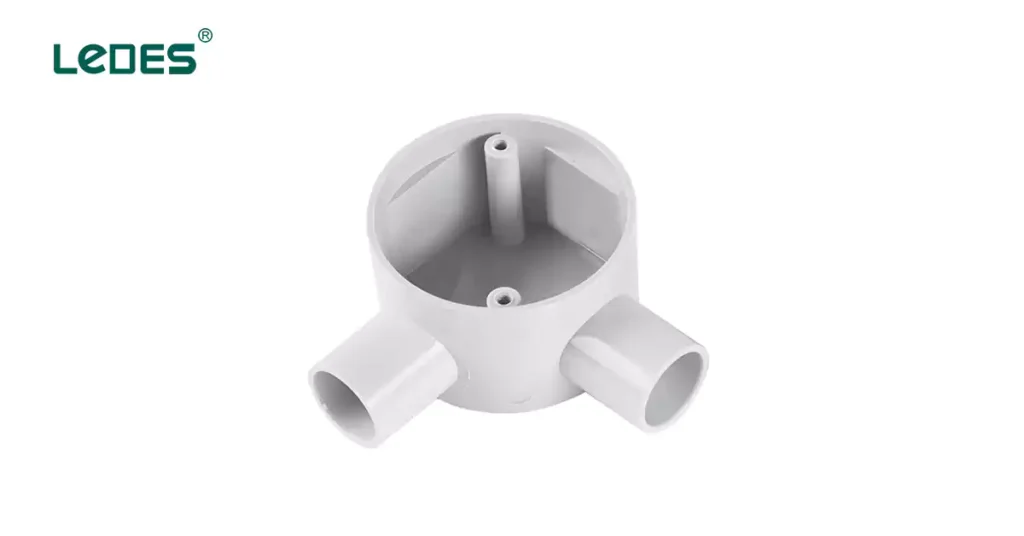
接线盒,也称为接线盒或 J 盒,是一种保护性外壳,用于容纳和保护电线连接和电线接头免受环境因素和意外接触的影响。它们通常安装在屋顶、墙壁和混凝土灰泥中。它充当中央枢纽,可将多根电线牢固地连接在一起。接线盒对于确保电气安全、整理电线以及遵守法规和规定至关重要。
将 PVC 导管连接到接线盒时,应考虑 3 个因素:
导管尺寸和兼容性: 确保 PVC 导管的尺寸与接线盒上的敲击孔或开口相匹配。使用专为 PVC 导管设计的连接器或配件建立牢固的连接。
接地: 遵守电气规范和规定,确保正确接地。对于金属接线盒,请将接地线牢固地连接到接线盒上。这有助于防止电气危险并确保符合安全标准。
保护和密封: 在 PVC 导管进入接线盒的地方使用适当的垫圈或衬套,以保护导管免受磨损或损坏。考虑使用密封剂或垫圈密封导管与接线盒的连接,以增强对湿气和污染物的防护。
可适应盒子(定义和目的)
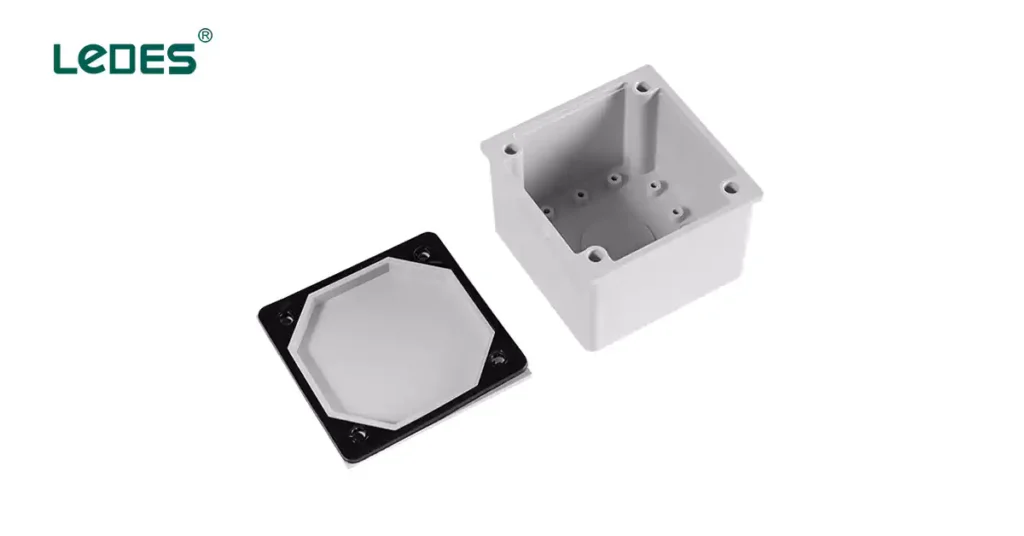
适应性盒子,也称为 适配接线盒 或可适应外壳,是一种用于容纳各种导管、电缆和接线连接的电气箱。这些电气箱在可容纳的导管类型和尺寸方面具有灵活性和多功能性,使其适用于各种电气安装。
可适配箱通常用于住宅、商业和工业电气应用,这些应用需要连接多个导管或电缆,或者可能需要未来进行修改或添加。它们为布线和保护电线提供了一种方便的解决方案。
导管体(定义和目的)
导管体是一种连接保护管道的连接器,允许电线在不同位置之间通过。导管体有多种类型,每种类型都有其独特的电线重定向功能。导管体充当中间点,导管可以在此连接、改变方向,并可用于维护或拉线。导管体在确保正确的导管管理、方便电线布线以及保持符合电气规范和法规方面发挥着至关重要的作用。
开关盒(定义和用途)
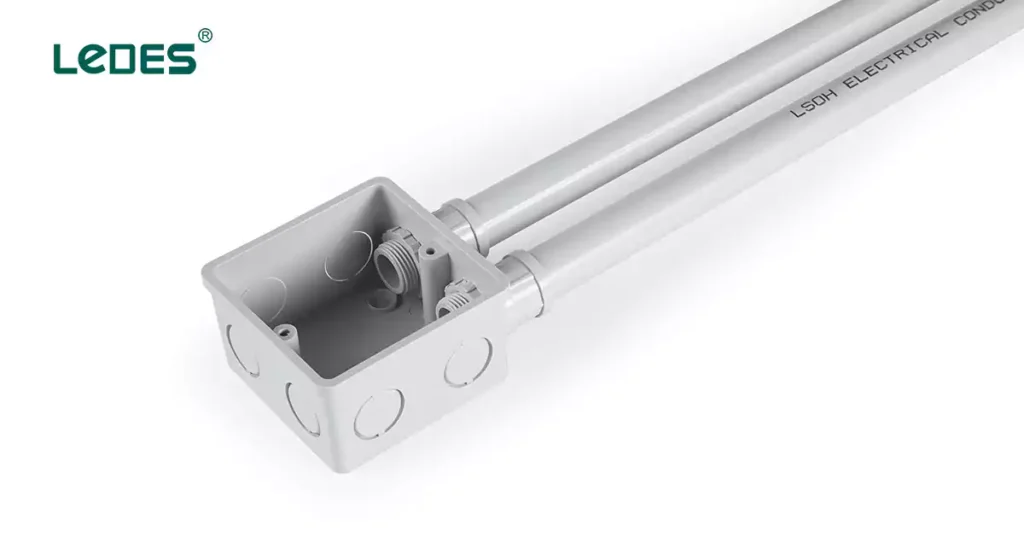
开关盒是一种金属或塑料电气外壳,安装在墙内,用于容纳电灯开关的工作部件。这些盒子为与开关和插座相关的电气连接提供了一个安全有序的外壳。
2 种不同类型的开关盒:
开关盒有多种设计,可满足不同的安装需求:
单联开关盒: 这些盒子最为常见,用于安装单个开关或插座。它们为基本安装提供了紧凑的解决方案。
多联开关盒: 多联开关盒用于需要并排安装多个开关或插座的情况,每个设备都有单独的隔间。它们确保外观整洁有序,并简化了布线管理。
插座盒(定义和用途)
一个 出线盒 是电气系统内的保护外壳,电线被安置在其中并连接到开关和电器等设备。这些盒子为电气连接提供保护,并方便插座的安装和维护。
2 种不同类型的插座盒
单联插座盒: 这些盒子通常用于安装单个插座或插座。它们为基本安装提供了紧凑而高效的解决方案。
双联插座盒: 双联盒尺寸较大,适用于需要并排安装多个插座的情况。它们为每个插座提供单独的隔间,确保外观整洁有序。
接线盒(定义和用途)
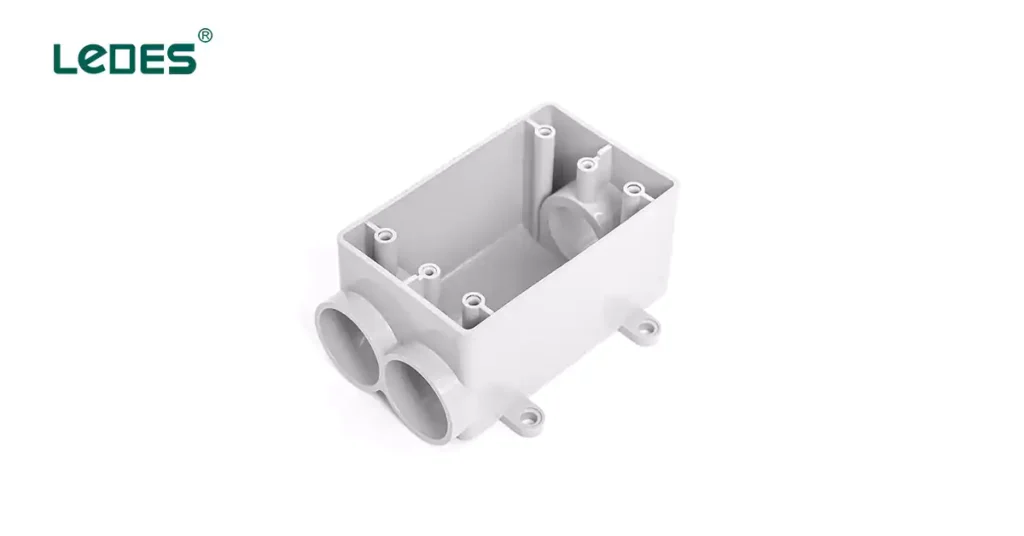
一个 接线盒 是一种电气外壳,通常由塑料或金属制成,安装在表面以容纳和保护一组电气设备,如开关和插座。它为电线和连接提供安全有序的外壳,保护它们免受损坏,并提供方便维护或修改的手段。
如何将 PVC 导管连接到电气箱
将 PVC 导管连接到电气箱需要小心谨慎,以确保连接安全可靠。我们列出了刚性导管和柔性导管的三种不同连接方式,您可以按照以下步骤将 PVC 导管连接到电气箱:
准备
收集必要的工具和材料:
- PVC 导管和适当的连接器
- 锁紧螺母、衬套、螺纹连接器、压缩配件或推入式连接器
螺丝刀、扳手或合适的工具
- 螺纹脂或胶带(如果使用螺纹连接)
确保电气箱正确安装并接地:
- 确保配电箱按照适用的电气规范和规定牢固安装并正确接地。
- 检查盒子是否适合预期用途并与 PVC 导管连接兼容。
确认尺寸和类型:
- 确保 PVC 导管直径与配电箱上的敲除孔或连接器相匹配。
- 确认配电箱是为所使用的特定类型的 PVC 导管(刚性或柔性)设计的。
敲除连接(10 个步骤)
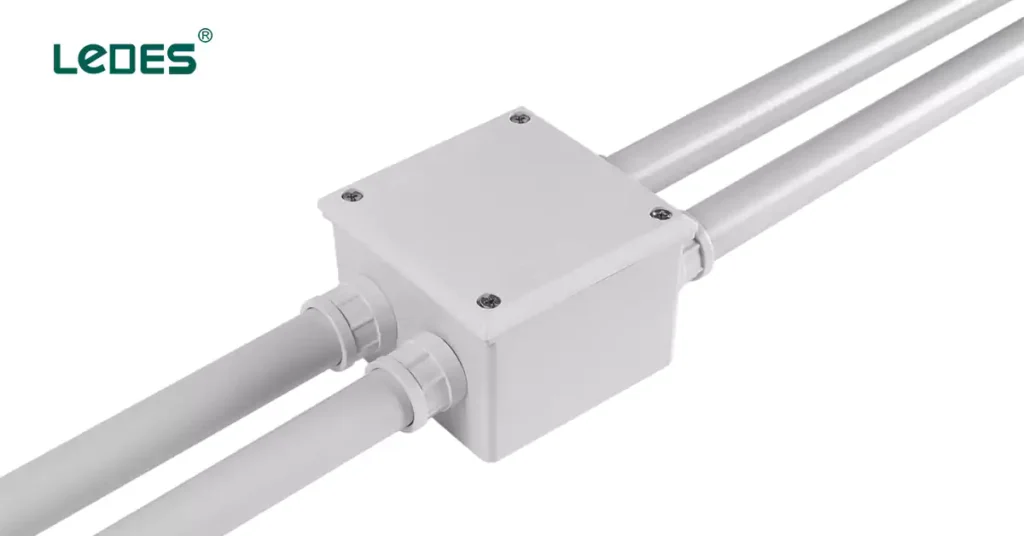
通常设计有敲孔的盒子通常与硬质 PVC 导管一起使用。例如可适应的盒子和开关盒。对于这些盒子,以下是将它们与 PVC 导管连接的一般准则:
- 收集必要的材料: 您将需要 PVC 导管、PVC 连接器、PVC 胶水、钢锯或 PVC 切割机、美工刀、螺丝刀和开关盒。
- 测量并切割 PVC 导管: 测量将开关盒连接到所需位置所需的导管长度。使用钢锯或 PVC 切割器将导管切割至适当长度。确保切口平直且干净。
- 准备导管末端: 使用美工刀去除导管切割端的任何毛刺或粗糙边缘。这将确保导管与开关盒连接时能够正确贴合。
- 连接 PVC 连接器: 将 PVC 连接器(例如适配器)滑到导管的两端。连接器应紧密贴合导管两端。
- 涂抹 PVC 胶水: 将 PVC 胶水涂抹在每个连接器的内部和导管末端的外部。务必遵循 PVC 胶水关于干燥时间和应用的说明。
- 将导管插入开关盒: 找到与导管对齐的开关盒上的敲除孔。将导管的一端轻轻插入敲除孔。用力将其推入,直到其完全固定在盒子中。
- 固定导管: 在开关盒内,使用螺丝刀拧紧 PVC 连接器上的螺丝。这将固定导管并形成紧密的密封。
- 重复上述步骤,以连接更多的导管: 如果需要将多个导管连接到开关盒,请对每个导管重复步骤 2-7。
- 测试连接: 完成所有导管连接后,请仔细检查它们是否牢固并正确安装在开关盒中。确保没有松动的部件或间隙。
- 跟进接线: 将导管牢固地连接到开关盒后,您可以根据需要按照电气规范和规定进行接线。
直接连接(9 步)
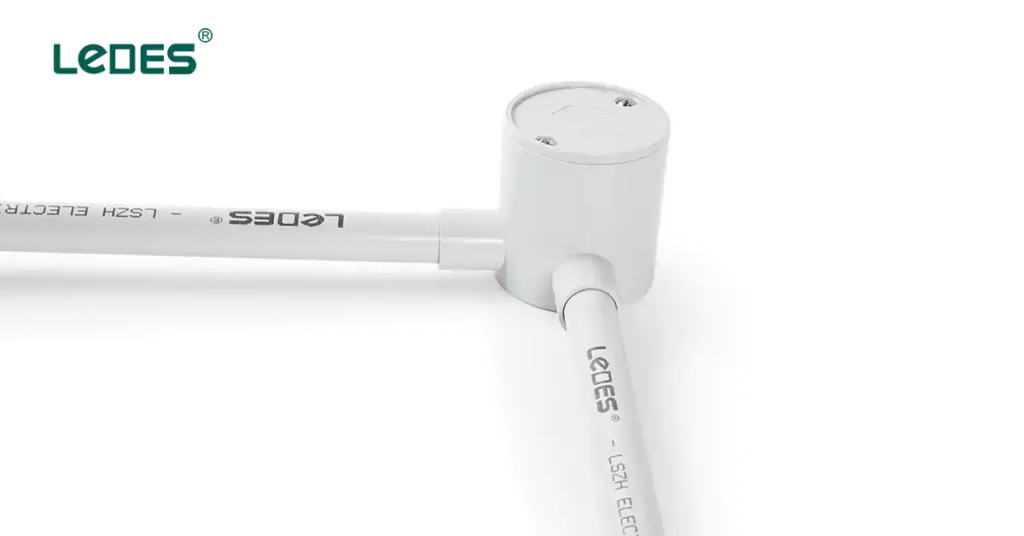
接线盒和导管体等电气箱体在箱体上设计有集线器,可仅使用 PVC 溶剂胶直接与硬质 PVC 导管连接,以下是连接步骤。
- 测量并切割 PVC 导管: 使用钢锯或 PVC 切割器测量并切割 PVC 导管至所需长度。确保导管切割成直角,以形成干净笔直的末端。
- 去除所有毛刺: 使用美工刀或去毛刺工具去除导管切割端的任何毛刺或粗糙边缘。这将有助于确保正确安装和牢固连接。
- 清洁导管和盒子: 用干净的布擦拭导管外部和配电箱内部(如接线盒和导管主体),清除任何污垢、灰尘或碎屑。这将有助于确保表面干净,以便 PVC 胶水有效粘合。
- 涂抹 PVC 底漆(如需要):一些 PVC 胶粘剂制造商建议在涂抹胶粘剂之前先在导管和盒子上涂一层 PVC 底漆。底漆有助于清洁和准备表面,以便更好地粘合。查看制造商的说明以确定是否需要涂抹底漆。
- 涂抹 PVC 胶水: 在导管末端的外部涂抹大量 PVC 胶水,覆盖导管长度约 2 至 3 英寸。此外,在盒子上的轮毂开口内部涂抹 PVC 胶水。
- 将导管插入盒子: 将导管牢固地插入盒子的轮毂开口,确保紧密牢固。稍微旋转导管,使胶水均匀分布,使导管和身体之间牢固结合。
- 固定到位: 将导管固定几秒钟,让 PVC 胶水凝固并形成牢固的连接。遵循制造商建议的 PVC 胶水固化时间。
- 重复上述步骤,以连接更多的导管: 如果将多个导管连接到同一导管体,请对每个导管重复步骤 1 至 7。
- 允许适当固化: 完成连接后,请按照制造商的建议留出足够的时间让 PVC 胶水完全固化,然后再对安装的导管施加压力或拉动。
推入式连接(7 个步骤)
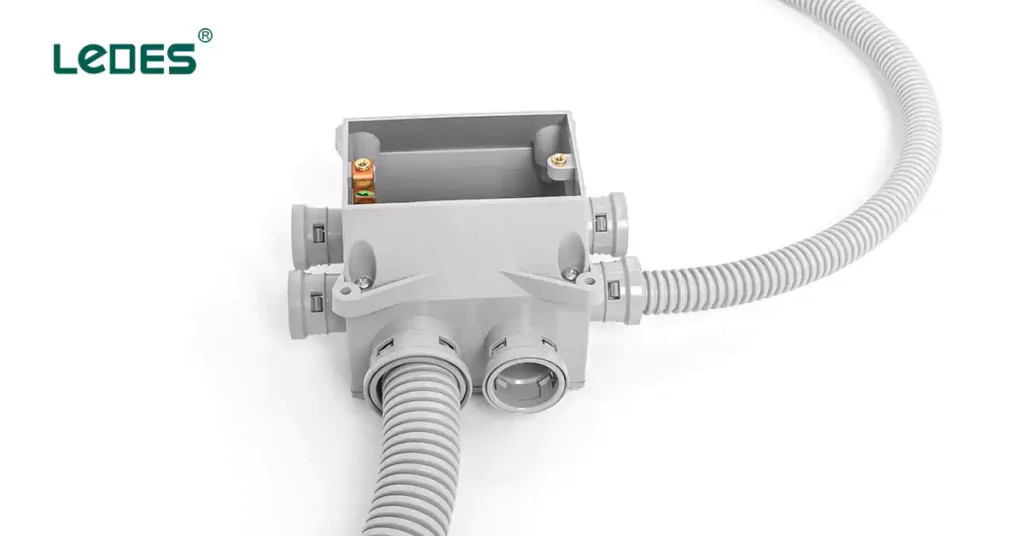
对于这些设计有接片的电气箱,例如接线盒、天花板盒,通常与柔性和波纹导管连接,这些盒子的连接不需要额外的工具或连接器。以下是将它们连接到 PVC 柔性导管和管子的一般指南。
- 准备波纹管: 使用钢锯或导管切割器测量并切割波纹导管至所需长度。确保导管切割成直角,以形成干净笔直的末端。
- 检查电气箱: 检查盒子(例如接线盒和天花板)是否有任何损坏或缺陷。确保盒子上的接片或连接器完好无损且状况良好,以便正确连接。
- 将导管与盒子对齐: 将波纹管的切割端抵在盒子上的凸片或连接器上。确保导管正确对齐,以牢固地安装在盒子上。
- 将导管推到盒子上: 用力均匀地将导管推到盒子的接头或连接器上。导管应滑动或卡入到位,形成牢固的连接。
- 检查连接: 检查连接,确保导管牢固地连接到接线盒。确认接头或连接器已与导管的波纹接合,从而提供紧密可靠的连接。
- 重复上述步骤,以连接更多的导管: 如果将多个导管连接至同一个盒子,请对每个导管重复步骤 1 至 5。
- 确保正确对齐和就位: 确认所有导管均已正确对齐并固定在接线盒的接头或连接器上。这将有助于确保整个安装的安全可靠连接。
通过遵循这些步骤,您可以成功地将 PVC 导管连接到配电箱,确保电气安装安全可靠。遵守电气规范和规定并查阅制造商关于您所使用的特定导管箱和波纹导管的说明非常重要。如果您对电气工作不确定或缺乏经验,建议向合格电工寻求帮助。
何时使用塑料或金属电气箱
塑料和金属电气箱各有其适用用途。 Romex 电线和塑料接线盒通常成对使用,尤其是用于室内插座,尽管根据项目的不同,金属外壳也可能适用。使用金属导管和塑料盒通常是不安全的,并且违反电气规范。
PVC 过热会熔化,但导电性不如金属。非金属线缆进出接线盒时,请使用塑料接线盒,因为金属护套电线需要与金属电箱接地,因此不应使用塑料接线盒。
让我们探讨一下塑料或金属电箱的常用场景,并讨论它们的优缺点。
塑料电器箱:
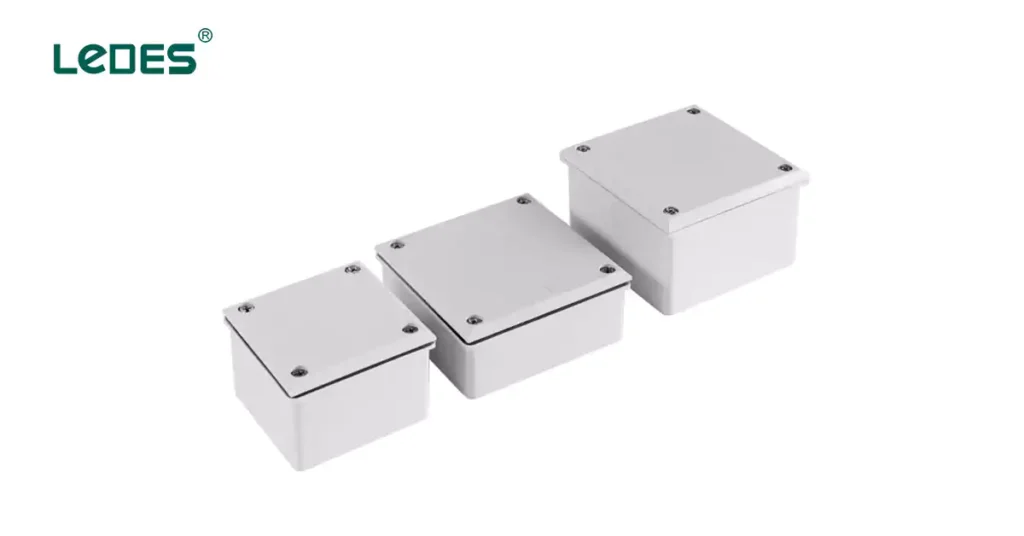
塑料电气箱通常由 PVC 或聚碳酸酯制成,具有多种优点,适合各种安装
优点:
非导电: 塑料盒不导电,也就是说它们不导电。这一特性使其成为需要将导电性降至最低的情况的理想选择,例如潮湿或腐蚀性环境。
安装简便: 塑料箱重量轻,使用方便。可以使用钉子、螺丝或粘合剂快速安装。塑料箱灵活,可轻松进行调整和修改。
经济高效: 塑料箱通常比金属箱便宜。这种经济实惠的价格使其成为住宅应用和预算有限的项目的热门选择。
耐腐蚀性: 塑料具有耐腐蚀性,因此塑料电箱适合用于户外安装或暴露在潮湿环境中的区域。
缺点:
力量有限: 塑料箱可能不如金属箱坚固,这会影响其在重型应用或容易受到物理冲击的位置的适用性。
耐热性有限: 塑料可能不如金属耐高温。因此,对于涉及高瓦数或发热设备的安装,一般不建议使用塑料盒。
金属电器箱:
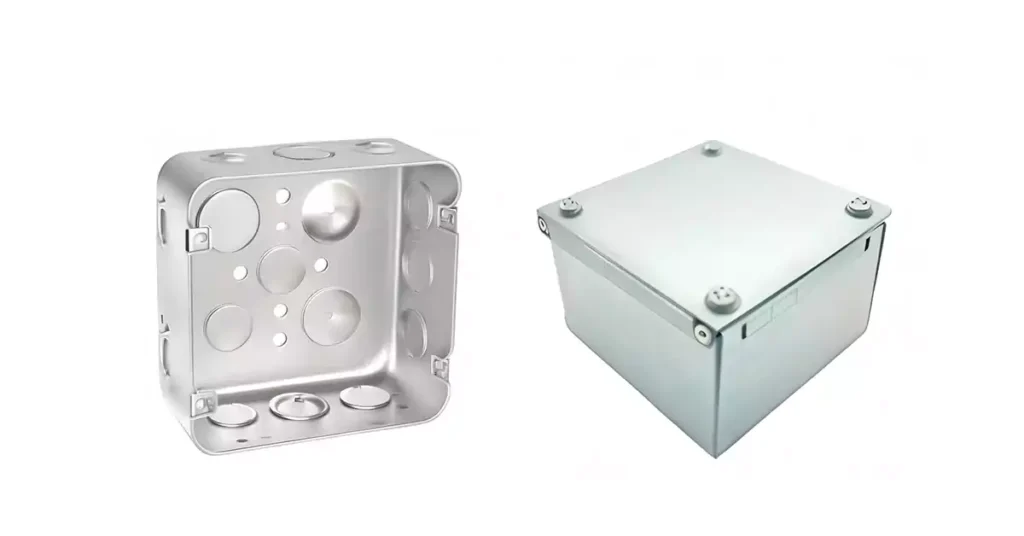
金属电气箱通常由钢或铝制成,具有独特的优势,适用于特定应用:
优点:
耐久性和强度: 金属盒非常耐用,可为电气连接提供出色的保护。它们不易因撞击而损坏,因此适合工业或商业环境。
耐热性: 金属盒比塑料盒更能承受更高的温度,使其适用于涉及产热设备或高瓦数电路的应用。
接地能力: 金属盒因其导电特性而具有固有的接地能力。这使得它们成为某些安装中接地要求的必需品。
缺点:
电导率: 金属箱会导电,如果接地不当,可能会带来安全风险。必须注意确保金属箱正确接地,以防止触电。
腐蚀电位: 如果暴露在潮湿或腐蚀性环境中,金属盒会随着时间的推移而生锈或腐蚀。对于室外或潮湿环境,应考虑采取适当的保护措施,例如使用耐腐蚀涂层或不锈钢盒。
成本: 由于所涉及的材料和制造工艺,金属盒通常比塑料盒更贵。
塑料盒与金属盒的常见使用场景
总而言之,以下是通常使用塑料或金属电气箱的一些常见场景:
塑料电器箱: 住宅应用、干燥的室内环境、成本敏感的项目、非导电要求以及耐腐蚀性至关重要的安装。
金属电器箱: 商业或工业应用、户外设施、高热环境、接地要求以及需要提高耐用性和抗冲击性的场所。
在选择塑料和金属配电箱时,请考虑具体的安装要求、预算、环境条件和所涉及的电气负荷。始终遵守当地电气规范和规定,以确保安全合规的安装。
安全安装配电箱的 11 个技巧
在使用电气系统时,安全应是重中之重。电气安装涉及固有风险,采取必要的预防措施对于安装人员和建筑物居住者的安全至关重要。以下是一些需要牢记的关键安全注意事项:
4 个关于穿着和装备的提示
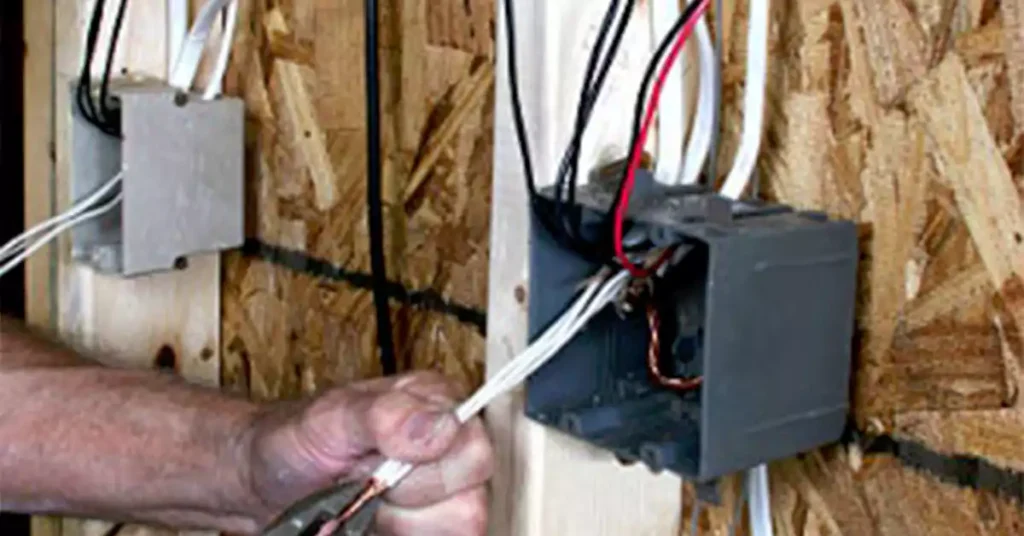
使用电力存在固有危险,包括触电、烧伤和火灾危险。在整个安装过程中,必须意识到这些风险并采取适当的安全预防措施。一些重要的安全措施包括:
- 穿戴个人防护设备 (PPE):始终穿戴适当的 PPE,例如绝缘手套、安全眼镜和防护服,以防止电气危险。
- 确保能力:电气工作应由在电气安装方面知识渊博、受过培训且经验丰富的人员进行。如果您对工作的任何方面不确定,请咨询合格的电工。
- 保持安全的工作环境:保持工作区域干净、整洁,没有潜在危险。避免在水源附近或潮湿的环境中工作。
- 使用适当的工具和设备:使用专为电气工作设计的绝缘工具。定期检查工具是否有任何损坏,必要时更换。
电源的 3 个技巧
在连接任何电气箱之前,务必关闭工作电路或区域的电源。这一预防措施对于防止触电和受伤至关重要。关闭电源时请遵循以下步骤:
- 确定控制工作特定区域电源的正确断路器或保险丝。
- 关闭断路器或取出保险丝,确保电源完全断开。
- 在进行任何工作之前,请使用电压测试仪验证电路或电线中没有电压。
遵守电气规范的 4 个技巧
为了确保电气安装的安全性和合规性,遵守当地电气规范和法规至关重要。这些规范为正确安装、接地和其他安全措施提供了指导。以下是一些需要考虑的关键点:
- 熟悉您所在地区适用的电气规范和法规。这些规范可能因管辖区而异。
- 遵守电气箱、导管、连接器和其他组件的选择和安装指南。
- 确保电气箱按照电气规范中概述的要求正确接地。接地不当可能导致电气危险和设备损坏。
- 定期检查和维护电气装置,以确保其符合最新的规范和规定。
结论
总之,配电箱在电气安装中无处不在且必不可少,配电箱有很多种类型,每种类型可能有不同的安装要求,因此正确安装配电箱对于电气系统的安全性和功能性至关重要。无论使用塑料还是金属配电箱,了解它们的优点、局限性和适当的应用都是必不可少的。通过遵循建议的指导方针和安全预防措施,并遵守当地法规,您可以确保安装成功并最大限度地降低电气危险的风险。
对电气系统解决方案有任何疑问, 请随时联系我们。



